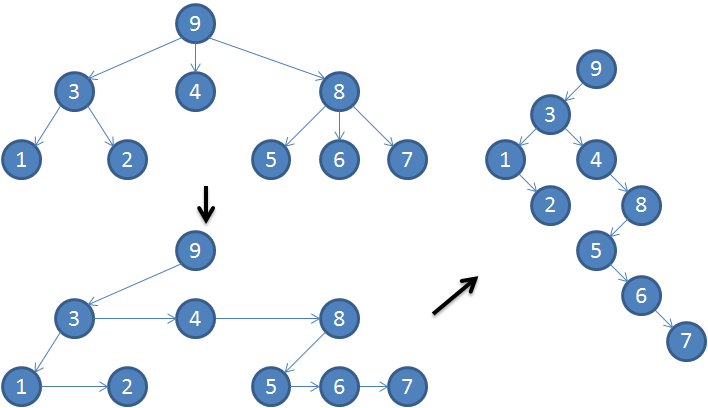簡介
在樹狀結構中我們可能會使用陣列或指標來表示子節點,然而許多的陣列或指標並沒有真的利用到,造成記憶體上的浪費。透過特定的儲存方式,能夠將各種樹都轉換成二元樹,就能有效解決這個問題。轉換的規則如下:
- 原節點的第一個子節點轉成二元樹中的左子節點 。
- 原節點的下一個兄弟節點轉成二元樹中的右子節點。
從圖形的角度來看也可以這樣說:
- 原節點的第一個指標指向第一個子節點。
- 原節點的第二個指標指向下一個兄弟節點。
轉換過程以下面這張圖為例:

左上角的圖表示原來的一般樹,從圖形的角度並以節點3為例,透過規則1將節點3的第一個指標指向第一個子節點,第一個節點我們簡單取最左邊的節點,為節點 1;透過規則 2 將節點 3 的第二個指標指向下一個兄弟節點,為節點 4。
其他以此類推,接著我們可以得到左下角的圖形,與原來的規則做對應我們可以知道,第一個指標指的就是二元樹的左子節點,第二個指標就是右子節點,所以依據左右子節點的位置重新調整圖形,最後可以得到右邊的徒刑,也就是轉換成二元樹的結果。
LCRS Tree
從上面的轉換結果,我們可以知道這個二元樹的左子節點代表的是原來的第一個子節點,右子節點代表下一個兄弟節點,而這樣的性質的樹也稱為 LCRS Tree(Left-Child-Right-Sibling Tree)。
原始的樹如果在後序 (Post-order) 的情況為排序好的,再轉換為二元樹後,也同時會是一個二元搜索樹。
語法
這邊利用之前文章寫過的樹和二元樹程式來做轉換。
C#
1
2
3
4
5
6
7
8
9
10
11
12
13
14
15
16
17
18
19
20
21
22
23
24
25
26
27
28
29
| using System;
using System.Collections.Generic;
using System.Linq;
using System.Text;
using BinaryTree;
using Tree;
namespace LcrsTree
{
public class LcrsTree
{
static public BinaryTree<T> Convert<T>(Tree<T> tree)
{
BinaryTree<T> binaryTree = new LinkedBinaryTree<T>(tree.Value);
IEnumerator<Tree<T>> enu = tree.Children.GetEnumerator();
if (enu.MoveNext())
{
binaryTree.AddLeft(Convert(enu.Current));
BinaryTree<T> node = binaryTree.Left;
while (enu.MoveNext())
{
node.AddRight(Convert(enu.Current));
node = node.Right;
}
}
return binaryTree;
}
}
}
|
Java
1
2
3
4
5
6
7
8
9
10
11
12
13
14
15
16
17
18
19
20
21
22
| import java.util.Iterator;
public class LcrsTree {
static public <T> BinaryTree<T> convert(Tree<T> tree) throws Exception
{
BinaryTree<T> binaryTree = new LinkedBinaryTree<T>(tree.getValue());
Iterator<Tree<T>> iterator = tree.children().iterator();
if (iterator.hasNext())
{
binaryTree.addLeft(convert(iterator.next()));
BinaryTree<T> node = binaryTree.left();
while (iterator.hasNext())
{
node.addRight(convert(iterator.next()));
node = node.right();
}
}
return binaryTree;
}
}
|
C++
1
2
3
4
5
6
7
8
9
10
11
12
13
14
15
16
17
18
19
20
21
22
23
24
25
26
27
28
29
30
31
32
| #ifndef LCRSTREE_H
#define LCRSTREE_H
template<typename T>
class LcrsTree
{
public:
LcrsTree() {}
virtual ~LcrsTree() {}
static BinaryTree<T>* convert(Tree<T>* tree)
{
BinaryTree<T>* binaryTree = new LinkedBinaryTree<T>(tree->getValue());
TreeList<string>* children = tree->children();
children->begin();
if(Tree<T>* child = children->next())
{
binaryTree->addLeft(convert(child));
BinaryTree<T>* node = binaryTree->left();
while (child = children->next())
{
node->addRight(convert(child));
node = node->right();
}
}
return binaryTree;
}
protected:
private:
};
#endif
|
延伸閱讀
樹 (Tree)
二元樹 (Binary Tree)
二元搜索樹 (Binary Search Tree)
樹的走訪 (Tree Traversal)


